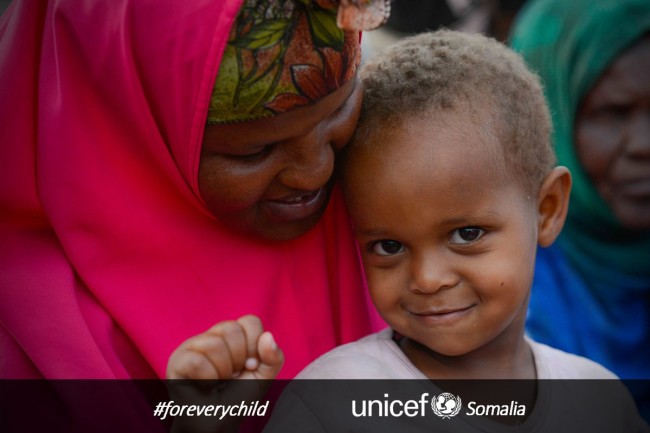Infant and maternal deaths still highest in Somalia but gradual decline is remarkable-UNICEF

One in seven children dies before their 5th birthday while at least 732 maternal deaths occur in every 100,000 live births in Somalia but a gradual decline in these deaths have been recorded in the last decade, the UN children’s body, UNICEF said Monday.
In a report released in Mogadishu today, UNICEF said Somalia still records some of the highest infant and maternal deaths only outpaced by countries such as Sierra Leone, South Sudan, Central Africa Republic and Chad.
Neonatal challenges, acute respiratory illness, diarrhea, vaccine preventable diseases and malaria top the list of the contributory factors to what UNICEF terms unacceptably high levels of neonatal, infant and child mortality.
The high number of deaths among mothers during birth relates to the fertility rates which is one of the highest in the world, at average of 6.6 children per woman in Somalia, the report notes. This, the UN agency attributes to common incidences of early marriage, low birth spacing and lack of access to contraception.
Only a third of births are attended by skilled staff while a quarter of expectant women receive antenatal care, factors leading to high maternal rates, UNICEF says.
To ensure these trend is reversed, UNICEF Representative in Somalia Steven Lauwerier has called for concerted efforts particularly in government to given precedence to the welfare of children in all its policies.
Noting the adoption of the Convention on the Rights of the Child last year by Somalia as a remarkable step, Lauwerier called for full implementation of the provisions of the Convention adding the future of Somali children is dependent on the government’s commitment to actualizing the Convention.
“Somalia’s success in reaching the Sustainable Development Goals will depend largely on how well it is doing to fulfill the promises made to Somali children,” said Lauwerier.
Every child, Lauwerier noted must enjoy rights under the convention and ‘we will not be able to call our work in Somalia a success unless and until, collectively we achieve this for children.’
But the report points to some remarkably positive developments which could lead to a more decline in maternal and infant/child death rate. Notable is the decline of malaria deaths which UNICEF attributes to sensitization on use of insecticide treated mosquito nets and part due to long periods of droughts recorded between 2009 and 2010.
Though there is little up to date data to gauge progress especially on maternal mortality rates, Dr. Maryan Qasim, a consultant with UNICEF and advisor to Somali Prime Minister says the number of women dying during birth has declined. “The figures were about 1200/100,000 but notably through the Joint Health and Nutrition Programme in 2012 they have reduced to what we have recorded today at 732/100, 000,” said Maryan.
The Situation Analysis of Children in Somalia 2016 report is the second comprehensive report coming ten years after the Multiple Indicator Cluster Survey in 2006. It covers five thematic areas-health, nutrition, water, sanitation and hygiene; education and child protection.